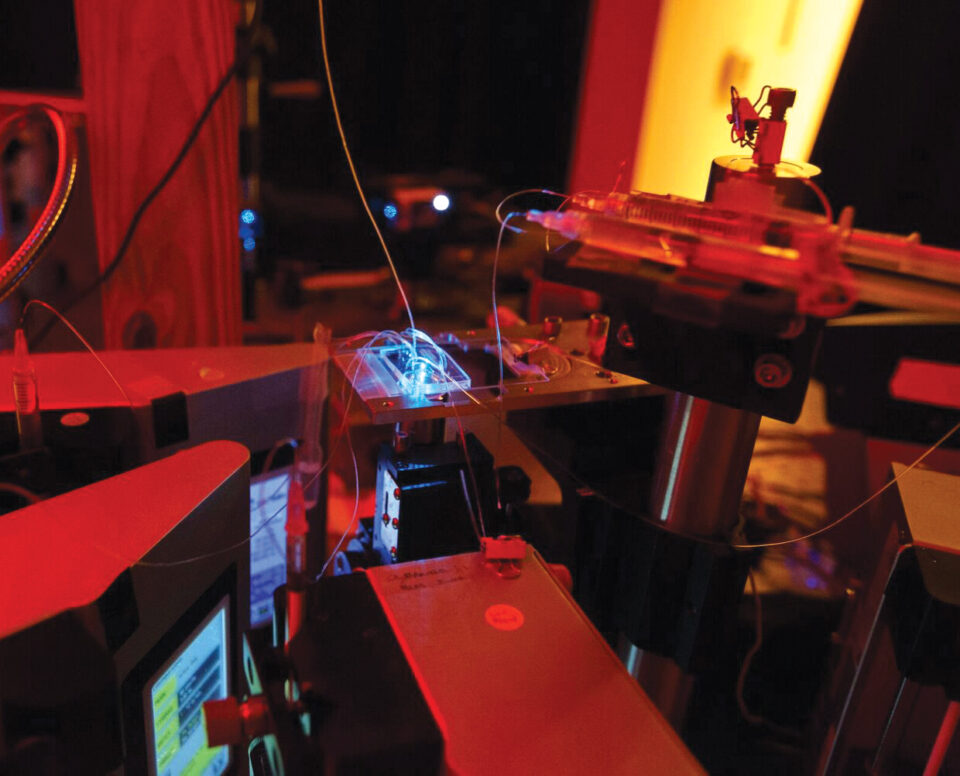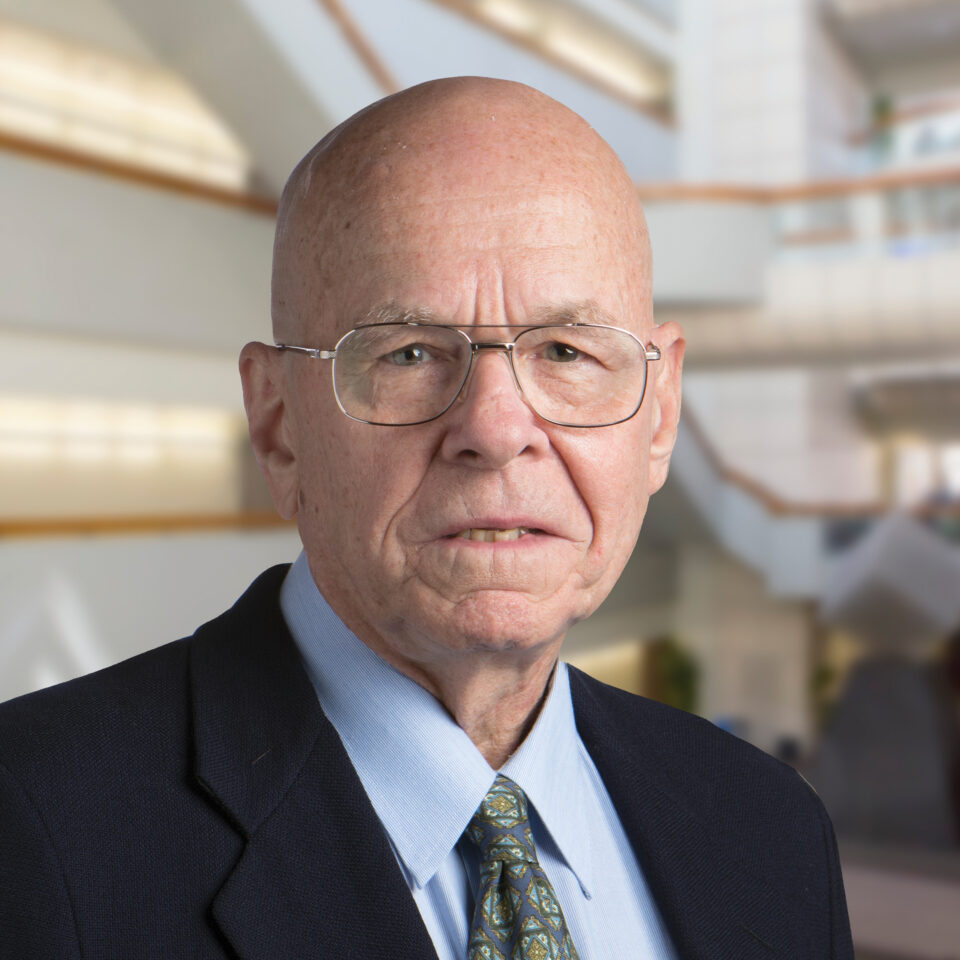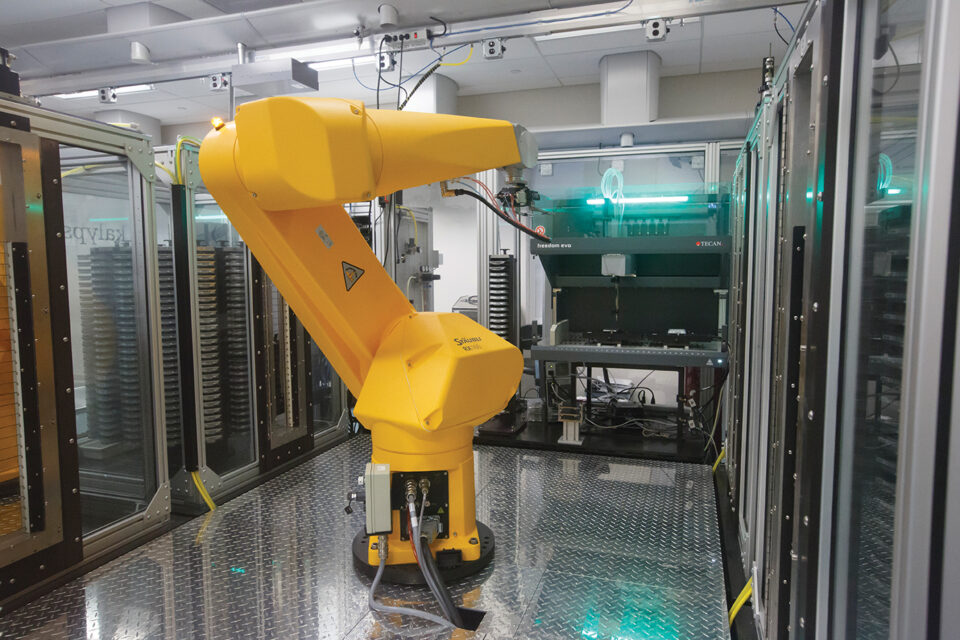
An innovative approach to chemistry and drug discovery that clicks.
Think about the sound that Legos make when they snap together. They click.
In 2001, K. Barry Sharpless, PhD, won the Nobel Prize in Chemistry for his work on chiral catalysts. That same year, he published another body of work, just as impactful. Dubbed “click chemistry,” it described a collection of reactions that enable larger molecules to snap together easily, like Legos. What’s more, they link only with each other, without reacting with other nearby biological molecules. It was as though the chemistry world had received a gift of the best Lego set ever made.

Since then, Sharpless’ “click chemistry” has transformed how scientists approach drug discovery, bioimaging and much more. Sharpless’ paper, “Click Chemistry: Diverse Chemical Function from a Few Good Reactions,” published in the German scientific journal Angewandte Chemie with co-authors Hartmuth Kolb, PhD, and M.G. Finn, PhD, has been cited by other scientists 8,500 times, according to the Web of Science—an extraordinary number.
Also impressive is click chemistry’s impact on both science and society. New drug discovery methods, new medicines, new scientific tools, new bioimaging methods and contrast media—click chemistry has produced them all, catalyzing the field of biochemistry and transforming the global search for medicines.
Today, scientists at Scripps Research are working on faster, less costly, more efficient ways of creating the individualized therapies that genomic medicine demands. Click chemistry serves as a critical enabling technology for those new methods.
Click chemistry explained
Sharpless’ team described click chemistry as, “a fast, modular approach to find and manufacture new molecules and materials with superior properties, and at much lower cost.”
“The force at the heart of this discovery engine is almost entirely down to the rarity of the reactions we allow to be involved in the intermolecular module linking steps,” Sharpless adds. “These reactions need to be perfect. In other words, they need to produce 99.999-plus percent yield. Two of them that we discovered in 2002 and 2013 nearly are.”

“Asking good questions is vital. Strong inference, a multitude of working hypotheses, and the periodic table will never let you down.”
—K. Barry Sharpless, PhD
2019 Priestley Medal Address
James Williamson, PhD, the institute’s executive vice president of Research and Academic Affairs and a professor in the Department of Chemistry and the Department of Integrative Structural and Computational Biology, says click chemistry has enabled all sorts of discoveries that couldn’t be made any other way.
“Click chemistry is a reaction that gives us these unique properties: You can do it in water, and the two halves of the ‘click’ don’t click with anything else,” Williamson adds. “This enables anyone to join two molecules by clicking them together, which is useful for all kinds of experiments where you want to put a specific label in a certain position.”
Williamson studies how ribosomes, the cell’s protein-building factories, assemble and then build complex molecules that drive growth and life. His laboratory has used click chemistry to “tag” the newly synthesized proteins in bacteria for analysis of their synthesis and degradation rates.
Medicines inspired by nature
In his Nobel lecture, Sharpless recounted how he had loved fishing as a child. After joining Scripps Research in 1990, he frequently contemplated his science during long walks or runs along the Torrey Pines Mesa, the Pacific Ocean horizon by his side. In his mind, Sharpless said, he would turn over the three-dimensional shapes of various molecules, pondering how the molecules of life assembled and behaved. In the same way, he had once gazed at interesting sea creatures during childhood fishing outings.
In the seminal click chemistry paper, Sharpless observes that carbon dioxide serves as nature’s starting material. He notes that nature’s reactions happen mainly in water. He further observes that DNA molecules, proteins and polysaccharides are polymers—subunits linked together with carbon-based bonds. Click chemistry, then, was nature’s chemistry, using the same raw materials, in water, to make chains. Its elegant simplicity was seized upon by chemists across the globe, who began using it for many purposes, including assembling compound libraries for drug discovery.
Among the first beneficiaries were people with HIV. Viruses including HIV-1 use enzymes called proteases in the final phase of their maturation. Drugs designed to inhibit proteases have helped people infected with the HIV virus to lower their viral loads, so that today the life expectancy for a treated person with HIV compares with that of an uninfected person.
Click chemistry methods made it possible to assemble large “libraries” of potential drug molecules, to select for the optimal molecule. And so, with the HIV epidemic raging, protease-inhibiting libraries were made, enabling discovery of new and more effective drugs. Click chemistry has also been used to create “libraries” of potential drugs for diabetes, Alzheimer’s, Parkinson’s, cancer and many other diseases.
Today, to test these compound libraries at a large scale, scientists use plates of microwells—tiny test tubes—and robotic arms able to test hundreds of thousands of compounds in a matter of days. This industrial system does in short order what an individual scientist would once have needed years to accomplish with the standard tools, pipettes and test tubes.
If high-throughput robotic systems enabled by click chemistry are now the state-of-the-art in drug discovery, some scientists predict the future will be smaller. Much smaller–yet still made possible through Sharpless’ click chemistry.
Clicking toward the future
In the Jupiter, Florida, laboratory of Scripps Research Chemistry Professor Brian Paegel, PhD, lasers spark in a curtained-off back room. Researchers assemble spaghetti-like pieces of tubing onto microchips etched with channels. They’re preparing to test a collection of drug-like compounds for their ability to become novel antibiotics.
Paegel believes these microfluidic devices will one day supplant those futuristic-looking high-throughput screening robots. The robots are at work in pharmaceutical companies globally, and also at the Scripps Research-Florida campus and the Calibr translational drug discovery division at Scripps Research in La Jolla. These systems have revolutionized drug discovery. But they are expensive to build and operate, and ripe for disruption, he argues. To address the world’s vast and growing unmet medical needs and take advantage of genomic data, Paegel believes the future will require miniaturization.
“Miniaturization is what enables us to live our lives on computers and phones. It is what enables us to sequence genomes at a fraction of the cost of what we used to pay,” Paegel says. “This is what will unlock the human genome to drug discovery.”
Click chemistry enables the design of compound libraries for his miniaturized system. The compounds he’s working with now have antibiotic-like traits. He uses click chemistry to affix unique DNA barcodes to each new substance, so the results can be read using his microchips.
“Click chemistry is something that we use as a tool. It’s a given, it’s ubiquitous, like Legos,” Paegel says.
Williamson says what have made click chemistry such a gift to researchers are its simplicity, reliability, and ready availability of so many reagents for a wide variety of applications.
In April, the American Chemical Society presented Sharpless, Scripps Research’s W. M. Keck professor of chemistry, with the 2019 Priestley Medal, the highest honor the organization bestows. The society said it is recognizing Sharpless for multiple advances: “the invention of catalytic, asymmetric oxidation methods, the concept of click chemistry and development of the copper-catalyzed version of the azide-acetylene cycloaddition reaction.”
“Dr. Sharpless has made numerous contributions to chemistry that have each significantly moved the field forward,” said Thomas Connelly, Jr., PhD, executive director and CEO of the society, announcing the award. “His service to advancing chemistry is beyond measure.”

